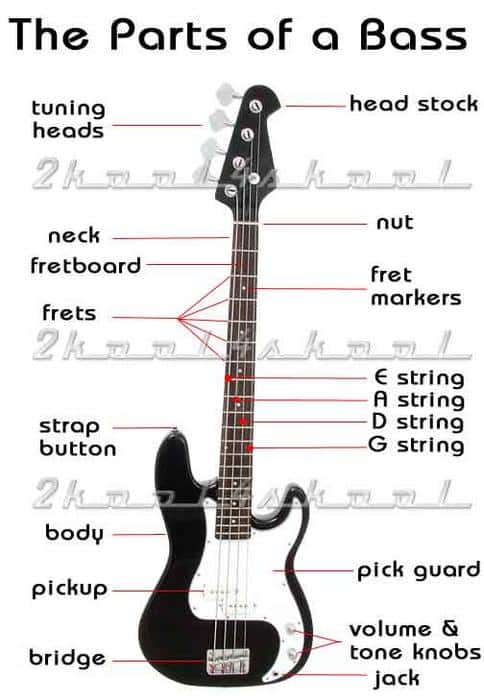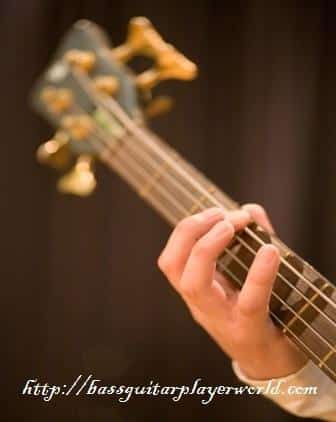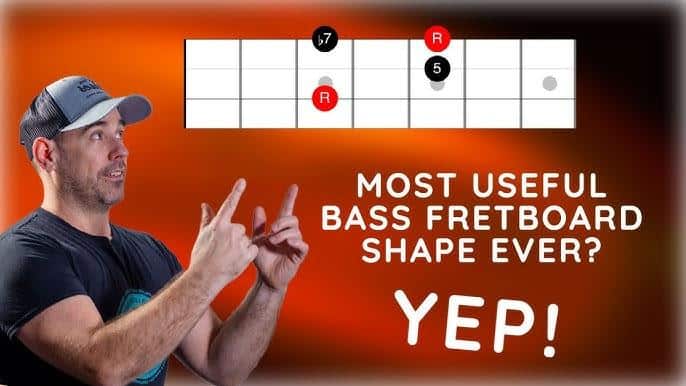Imagine a world without the resonating low-frequency rumbles that caress the soul – a world without the bass guitar. Now picture gazing at the crowd, fingers poised over the intricate bass guitar shapes– ready to set the stage alight. My journey into the art of lutherie began in 1994, ignited by a fascination with the engineering and artistry of bass guitars – their unique shapes and the immense versatility they offer in techniques.
Recent research suggests that the choice of a bass guitar goes beyond mere visual aesthetics; the shape plays a critical role in the sound produced. Unfortunately, I’ll have to leave you at the edge of your seat wondering just how this is possible.
An unexpected premise you must grapple with is this – the shape of a bass guitar does a lot more than tickle our aesthetic senses. It has a profound effect on the versatility and tonal range of your playing. But just how deep does the rabbit hole go? That is the mystery I aim to enfold.
As a former engineer and a longstanding member of the New England Luthiers, I am thrilled to take your hand and guide you through the nuances of bass guitar anatomy and the various bass guitar techniques .
History and Aesthetics of Bass Guitar Shapes
Evolution of Bass Guitar Designs

Embarking on the historical journey of the bass guitar, I am reminded of the evolution of unique bass designs that deepened the resonation of music for the listeners. Imagine if Paul Tutmarc did not transform the bulky, double-bass viol into the easily portable electric ‘bass fiddle’ in the 1930s – our music landscape could have remained restricted and thus bass creation, highly unexplored. This revolutionized bass design formed the groundwork for Leo Fender’s iconic Precision Bass in 1951, a breakthrough that brought forth an easy-to-amplify and travel-friendly musical instrument.
In my years of extensive research for the American Lutherie Journal, I’ve discovered myriad famous bass guitar designs that contributed significantly to the evolution of bass guitar aesthetics. Among them, the introduction of the Gibson EB-1 violin bass in 1953 brought forth a whimsical yet practical base design. This model inspired the creation of Paul McCartney’s signature Höfner violin bass, a design so distinctive that its silhouette can be recognized from a distance.
As we progressed to the 1960s, there was the Gibson Thunderbird with its unusual and iconic reverse-shaped body, and the Rickenbacker 4001, revered for its elegant ‘crested wave’ body shape and a rich ringing tone. These models have undoubtedly influenced a plethora of modern bass designs.
The essence of the 70s and 80s bass aesthetics saw the merging of music with amplified theatrics. It was impossible to ignore the Ibanez Iceman, with its exotic design and iconic status in the hard rock scene; or Alembic’s visually intriguing models that transformed the bass guitar into a bona fide work of art. These representations of avant-garde artistry allowed musicians to express their own unique identities, embodying their eclectic music styles with visually expressive uniqueness.
In recent decades, the divergence and fusion of bass design trends mirrored the proliferation of music genres and techniques. While traditional shapes remain popular staples, many luthiers have veered toward bold creative expressions. From unusual body shapes to exotic tonewoods—our understanding and appreciation of bass guitar aesthetics are continuously evolving.
Understanding this evolutionary journey of bass guitar design provides a profound appreciation for the instrument—its aesthetics, how it feels, how it plays, and most importantly, how it impacts our music-making journey. This historical overview of the bass guitar design reminds us that innovation, paired with aesthetics, shapes our auditory world. Embracing these changes, we gear up to explore the various types of bass guitar bodies in the following section, elucidating their influence on sound and playability.
Aesthetics and Types of Bass Guitar Bodies

Over my years in lutherie, I’ve developed a keen eye for the aesthetic nuances of various bass body types. In this section, I will walk you through my professional analysis of these features. This knowledge is key to understanding the correlation between aesthetics and types of bass guitar bodies, a vital part of the grand journey of mastering the art of bass.
The visual appeal of a bass guitar has a profound impact on its allure to the player and listener. The variety in electric bass body types has as much to do with aesthetics as does function. Body types, such as the solid body, semi-hollow, and full hollow, each have distinct appearances that mirror their unique tonal characteristics. The iconic solidity and presence of a Fender Precision or Jazz bass exude a certain visual aura, and the cool, retro vibe of a Hofner Beatle Bass is hard to ignore.
Furthermore, the bass guitar aesthetics hit a delicate balance between a striking appearance and pragmatic usability. The streamlined body of the popular ‘P-bass’ is not merely for show; it’s designed for balance and playability. The guitar’s contours and finishes also contribute to the overall aesthetics – they can transform a conventional design, making it truly the player’s own. Even the choices of wood – ash, alder, mahogany, or maple – contribute to the guitar’s aesthetic appeal and tonal flavor. A discerning eye can even see our musical history and culture in these aesthetic expressions.
In my experience, understanding these aesthetics enhances the musician–instrument bond—that mysterious connection a player senses when they find ‘their’ bass. It’s more than just a tool to make music; it becomes a part of one’s artistic expression. A deep dive into these vital details of bass guitar bodies enriches our grasp of the intricacies of bass guitar designs and how precisely they can mirror so much more than their visual charm.
Building on this foundation of aesthetics and body types, let’s shift focus in the next section to dissect and understand the anatomy of a bass guitar. This will further cement your perception of your instrument, not just as a means to generate music, but as an aesthetic object that stands a testament to an age-long history of artistic innovation – a perfect blend of form and function.
Understanding Bass Guitar Anatomy

Imagine a stage. The spotlight highlights a silhouette, and that silhouette is a bass guitar. The aesthetic appeal is more than captivating; it’s a testament to the architectural marvel of its design. In my years of studying and hand-crafting instruments, I’ve always been drawn to the subtleties of their anatomy, and the unique attributes that set them apart. So, what makes a bass guitar different from a regular guitar, and why should you care about its anatomy?
Unlike a regular six-stringed guitar, the bass guitar – typically with four strings – anchors the harmonic framework and lays down the rhythmic foundation in a band. Each component of its anatomy contributes heavily to its sound and playability, including the custom bass body shapes, double cutaway designs, the bass pickups configuration, and the often overlooked yet vital headstock design. Understanding the details of bass guitar anatomy can help you make more informed buying choices, properly maintain your instrument, and even enhance your playing technique – all integral aspects of mastering the art of bass guitar.
What fascinates me most, and what I believe you should understand first, is the silhouette of the bass guitar. Its unique contour, defined by a vibrant mix of curves and angles, contributes heavily to your comfort and effectiveness as a player. The double cutaway design, with two recesses in the body allowing access to higher notes on the fretboard, is a common feature. From the accuracy of the cutaways to the type and quality of the wood, the physique of a bass guitar has an enormous impact on its tonal characteristics.
As one might expect, the significance of bass guitar anatomy doesn’t stop at the body shape. The role of the bass pickups configuration is vital as it acts as the intermediary between you and the amplifier, translating the vibrations of the strings into electrical signals. Different pickups configurations can offer a variety of tones, which can subtly or drastically shape the sound of your bass. Getting familiar with these configurations is akin to discovering new soundscape to create your music.
Then there’s the headstock – the component you’d least expect to bear influence. From its size and shape to the arrangement of the tuning pegs, the headstock design influences both the intonation and sustain of your notes. Who could have thought that this seemingly insignificant block of wood could have so profound an impact on the very voice of your bass?
This foray into bass guitar anatomy is just the beginning, but in my experience, you can always trace an element of wonderful surprise back to the intricacies of the bass guitar’s design. The creativity and choices made by luthiers over the decades have resulted in a vast assortment of custom bass body shapes, each reflecting different factors such as tonal qualities, playability, aesthetic preferences, and even cultural backgrounds.
As each component of the bass guitars silhouette reveals its significance, a deeper appreciation and understanding of the instrument naturally follows. In my experience, this knowledge not only enhances your relationship with your instrument – it also amplifies your creative potential.
These detailed elements and thoughtful design characteristics embody what it truly means to understand, play, and master the bass guitar. By sharing my insights and experiences, I hope to inspire a new level of connection between you and your instrument. Of course, understanding bass guitar anatomy is just a single tune in the symphony of bass guitar mastery. So, let’s proceed further into our exploration and tune ourselves to the rhythms and patterns of bass guitar playing techniques, and the symbiotic relationship between bass lines, tuning, chords, fretboard shapes and ergonomics – all of which play their part in the dynamic and expressive world of bass guitar.
Bass Guitar Playing Techniques and Patterns
Creating Effective Bass Lines

As we shift our attention from playing techniques to the creation of effective bass patterns, remember that bass line creation truly embodies both art and science. Drawing from my own experiences and the extensive research I undertook for the American Lutherie Journal, I aim to navigate this vital aspect of bass guitar mastery with you, accentuating its relevance to our current theme.
At its core, bass line creation is about integrating rhythm, scales, and harmonies to produce compelling, robust soundscapes that form the backbone of any musical arrangement. It’s the compelling interplay of these elements that lends a unique texture to the music, dictating its groove, mood, and drive.
Initially, you need to understand the rhythm and key of the song you’re playing along with. Knowing the song’s key will inform you of the scale you’ll use, while the rhythm will guide your note placement timing. This is where bass hand positions come into play. By positioning your hand correctly on the strings and fretboard, you’re enabling efficient finger movement across the desired notes, helping you execute your bass lines with precision and ease.
Consider this, if you’re playing in the key of C major, your hand position should allow you access to all the notes within the C major scale. As you ascend and descend the fretboard, your hand maneuverability becomes integral, enhancing your ability to perform various bass patterns effectively.
Moving beyond the tuned scales and precise hand positions, the real meat of bass line creation is in the marriage of single-note patterns with chords and harmony. Consider not only the root notes of the given chords but also the other notes they encompass. Skilfully blending these aspects can result in a rich, grooving bass line that strengthens and enhances the overarching melody, delivering the iconic underpinning resonance and rhythm that we love in our favorite tunes.
Remember, mastering the art of bass guitar involves embracing the balance between theory and creativity. As a bassist, I can confirm that a thoughtful and harmonically astute bass line can often spell the difference between a good and a brilliant musical ensemble. The science lies in understanding the principles that govern effective bass line creation, the art lies in how you manifest these principles to enrich your sound and bring your music to life.
As we get set to further explore advanced bass playing techniques and patterns in the subsequent sections of this article, always remember the importance of deep, robust bass lines to any musical piece. The process of bass line creation requires skill, knowledge, and foresighted sumptuosity in equal measure, making it a critical facet to your overall bass guitar mastery.
With that in mind, let’s turn our attention to the next chapter: Mastering Bass Playing Techniques and Patterns, where we will drill deeper into the ways of tapping, plucking, and slapping that bass in the quest for a captivating sonic experience.
Mastering Bass Playing Techniques and Patterns

The art of mastering the bass guitar not only consists of knowing where to place our fingers or how to strum rightly, but also seeks a comprehensive grasp on its playing techniques and patterns. Drawing from my years as a luthier and a seasoned bass player, it makes me appreciate the importance of practising varied bass playing techniques as they create a multi-dimensional sound palette. So, let us delve deeper into such techniques and explore how effective mastery can enhance our bass playing prowess.
The first step, possibly the most critical, is gaining proficiency in fingerstyle bass patterns. Using the fingers rather than a pick offers a soft, more intimate touch to your bass guitar’s sounds. The tonal richness that it yields is something that a pick rarely mimics. Ideal for jazz, blues, pop, and rock, fingerstyle patterns foster dynamism in your bass lines, allowing your notes to breathe and make melodies speak in warm, human tones.
In juxtaposition, the slap bass techniques add another dimension to your bass playing arsenal. Inquisitively, it emerged out of a need for drum-like percussiveness in the groove. It is characteristically punchy, rhythmic, and resonant, serving as an anchor that glues the entire ensemble. As a bass guitarist, mastering these techniques represents not just rhythm, but also a different aesthetics of sound, that can dynamically interact with other instruments.
Lastly, competence in fretting techniques for bass can derive a cleaner sound output without buzzes and muffles. Understanding finger placement, managing pressure, and navigating the fingerboard—these nuances, when refined, can significantly improve accuracy and speed, as well as lowers the risk of physical strain.
Coupling these techniques with recognized patterns, I can create an evocative soundscape that serves the musical context while maintaining my unique sonic signature. The process of mastering these techniques and patterns was as much an intricate journey of discovering the voices within my bass guitar as it was about honing my skills.
To conclude this section, mastering the aforementioned bass playing techniques and patterns are indispensible flexibilities that can make you proficient across styles and effective across roles. It is a continual process, a dialogue between your musical instincts and the technical expertise, the outcome of which will be purely flourishing. Our next step is to utilise this technical prowess to create effective bass lines that serve the song and tell the stories we want to.
Bass Guitar Tuning and Chords

In my journey as a luthier, my unswerving fascination with the bass guitar led me to a nuanced understanding of the instrument’s modes, patterns, structures, and predominantly, its tuning techniques and chord structures. The knowledge of bass tuning and playing chords was a game-changer for me.
Before we delve deeper, here is an intriguing fact. Did you know that the way you tune your bass guitar can completely change its sound and feel? This nugget of wisdom had a significant impact on my approach.
Tuning is foundational to any instrument, and the bass guitar tuning is no exception. It holds the key to unlocking the instrument’s potential, making precise handling both a necessity and an art. A properly tuned bass guitar under your fingertips is like a finely tuned sports car at your command, responsive, purring, ready to roar.
Bass guitar, usually being a four-string instrument, is typically tuned to standard E, A, D, G, which are the same notes the four thickest strings on a six-string guitar are tuned to. However, depending on your musical style or the piece you’re working on, alternate tunings like Drop D, Half Step Down, Full Step Down, or D Standard might come into play.
Learning how to tune your bass guitar is not just about getting the right pitch, it’s also about the relationship between notes and the crucial role it plays in creating music. To truly master this art, one needs to acknowledge that the bass guitar isn’t tuned the same way as a regular guitar, it requires a more meticulous approach as one small adjustment can dramatically transform the overall sound.
Familiarizing yourself with different chord shapes on bass also happens to be a crucial part of this harmonic exploration. Chords are the crux of most songs and having a deep understanding of these on your bass guitar can elevate your playing to another level. A beginner may start off with the simplest form of power chords, which are root-fifth chords, played with two different notes.
As your skill levels advance, you might want to explore moveable bass chord shapes and dominant 7 shapes on bass. These moveable shapes are handy as you can freely shift them around the fretboard and drastically expand your playing possibilities. Dominant 7 shapes, on the other hand, are essential in blues and jazz music and add a lot of harmonic depth to your playing.
While playing bass chords might seem daunting at first, it’s exponentially rewarding once you’ve developed a knack for it. Bass chords represent the harmony of the melody, and when played correctly, they keep the music sounding rich and full, making them vital for any bass player to incorporate into their repertoire.
In my personal journey, discovering these aspects of bass guitar tuning and chord playing was like unlocking secrets to a whole new sonic world. But the journey of mastery is continuous and intertwined with perseverance and the joy of learning. As we proceed to explore the world of scales and fretboard shapes in the next section, I hope my discoveries will inspire and guide you on your journey through the art of mastering the bass guitar.
Scales and Fretboard Shapes on Bass

The bass guitar is perhaps the most underestimated instrument in a band. Its presence is subtle, yet vital, laying the foundation for melodies, enhancing the depth of songs and rhythm. Being a bass player myself, I embarked on a rigorous quest to truly master this captivating instrument, which involved an imperative step of understanding the bass fretboard. It’s a step often underestimated by many learners, but one that serves as a key to unlock the full potential of your bass.
So, why are the scales and fretboard shapes so vital in mastering the bass guitar?
Grasping the bass fretboard shapes and bass guitar scales can unlock an universe of melodic potential. Each fret, each string serves a purpose in the grand musical scheme; imagine a roadmap that leads to endless melody possibilities. As you navigate the fretboard, learning its shape and contour, scale patterns begin to emerge, connecting the dots in this musical puzzle, and offering a path to express yourself musically. This is why I have dedicated an inordinate amount of my research to dissecting the role scales play and understanding the layout of the fretboard.
My fascination for bass fretboard shapes began at an early stage in my bass playing journey. The seemingly random pattern of dots and lines soon began transforming into familiar forms; I started seeing pentatonic box shapes for bass. Pentatonic scales, derived from five-note sequences, hold an universal appeal. They are simple, versatile yet relentlessly powerful, and can be found in almost all genres of music, from the blues and rock to pop and country. Pentatonic box shapes are essentially visual representations of these scales across the fretboard, serving as invaluable mnemonic devices to learn and memorize these scale patterns easily.
As I deep-dived into the world of bass guitar scales, I discovered the myriad ways they could be used to create distinct basslines and solos. The Major and Minor scales seemed to be dominating a large portion of the music I was playing. These scales are like the two corners of a room, each leading to different avenues of melodies. Mastering these two scales on the bass fretboard gave me a sturdier basis to create varied and versatile basslines.
I distinctly remember the excitement of discovering the ‘box pattern,’ a powerful tool that could instantly reveal the notes of any scale. The box pattern is simply a pattern of frets that, once memorized, allows a bassist to instantly identify which notes are part of a specific scale. This seemingly simple pattern transformed my understanding of both bass fretboard shapes and scales.
Much of my research, explorations, and practice has affirmed the importance of scales and understanding of the bass fretboard in mastering this instrument. It’s not about rote learning or mindless practice, but rather about understanding, connecting, and feeling each note and its place on the fretboard. It’s this intimate familiarity that eases improvisation, helping bassists to instinctively weave melodious lines, enhacing the harmony between both the player and the instrument.
Learning the fretboard and scales is a journey, one that is as deeply personal as it is musical. In the following sections, I will delve deeper into how to effectively learn these scales, the nuances of the fretboard, and the dynamic world of bass guitar ergonomics. I encourage you to join me on this journey, for it is one intertwined with discovery, creativity, and self-expression.
Understanding Bass Guitar Ergonomics

After exploring the evolution of bass guitar designs, understanding the anatomy of these instruments, and delving into a variety of playing techniques and patterns, it’s time now to delve deeper into the world of bass guitar ergonomics. This aspect, often unnoticed or misunderstood by many players, is fundamental to the comfort, technical proficiency, and long-term health of the bassist. As a firm believer in the importance of instrument ergonomics, I have dedicated a significant portion of my career to researching and understanding this subject.
So, have you ever wondered why certain bass guitars just feel right when you grasp them, while others don’t?
This sensation can be attributed to the ergonomics of the instrument. The term ergonomics refers to the science of arranging and designing objects so that they fit the people who use them. Applied to a bass guitar, ergonomics becomes an essential consideration, shaping how you interact with your instrument on a physical level.
Over the years, I have come to understand that a well-optimized ergonomic design could be a game-changer for performing artists. It helps reduce unnecessary strain, allowing for smooth movement and, in turn, promoting better mastery over technique and sound.
The bass guitar ergonomics can be assessed on various parameters, such as body shape, weight, neck profile, fingerboard radius, and even the location of the strap buttons. The right combination of these attributes is crucial and depends greatly on your personal comfort, playing style, and physical characteristics.
One of the most critical aspects to consider is the guitar’s body shape. Different shapes offer unique balance points and comfort levels when sitting or standing. Examining the design and placement of the neck is also crucial; whether it’s a bolt on, set-in, or neck-through design will affect its balance and resonance. The choice of fretboard radius can impact the ease of executing certain techniques, like bending or chording.
Aside from the instrument’s physical characteristics, your approach towards holding and playing it also plays a considerable part in the ergonomics equation. This includes factors such as your posture, your plucking technique, and, most crucially, how you carry the instrument on your body.
With my experience and research, I learned that no one-size-fits-all answer in bass guitar ergonomics. It’s about individual preferences and comfort. Thus, I encourage you to experiment with various instruments and setups to find what suits you best. Pay close attention to how your body reacts to different shapes, weights, and orientations. After all, the ultimate goal of exploring ergonomics is to make playing your bass guitar a seamless, enjoyable, and pain-free experience.
As we progress further into this article, we will delve deeper into the realm of tuning, chords, scales, and fretboard shapes on bass, all of which can further influence the ergonomics of your playing. But for now, remember, a well-chosen and appropriately handled bass guitar can provide a joyful and intuitive playing experience while minimizing any potential physical strain or discomfort.
FAQs
What is the first step in mastering the art of bass guitar?
What are some common bass guitar techniques?
How can I understand different bass guitar shapes?
Conclusion
As we journeyed through the distinct chapters on mastering bass guitar shapes and techniques, we delved deep into the heart of this unique stringed instrument. We traced the evolution of bass guitar designs, understood the aesthetics of different bodies, and unfolded the intricacies of its anatomy. We discovered varied playing techniques and how to effectively create basslines.
Have you ever known a bass guitar to be much more than just a stringed instrument? We explored its tuning, chords, and distinctive fretboard shapes, all which encompass the anatomy of bass, a universe in itself. We grasped the importance of bass guitar shapes in terms of ergonomics, paramount to playing comfortably and proficiently.
I’ve woven in this fortified knowledge from years of lutherie into this guide, emphasizing the fundamental truth that the more you understand about the bass guitar’s structure and techniques, the closer you’ll get to perfecting its art. My journey as a music artisan has expanded my perspective vastly, and I hope this guide does the same for you.
In conclusion, mastering the art of bass requires patience, practice and a comprehensive understanding of various shapes and techniques. Take your time, let your fingers familiarize with different patterns, and soon, you’ll be enriching your music with the profound depth that is truly unique to the bass guitar.
